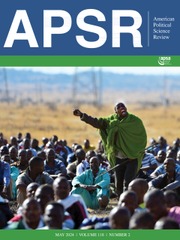Crossref Citations
This article has been cited by the following publications. This list is generated based on data provided by
Crossref.
VERDIER, DANIEL
1995.
The Politics of Public Aid to Private Industry.
Comparative Political Studies,
Vol. 28,
Issue. 1,
p.
3.
Osborne, Evan
1998.
A theory of gridlock: Strategic behavior in legislative deliberations.
Atlantic Economic Journal,
Vol. 26,
Issue. 3,
p.
238.
McCarty, Nolan M.
and
Poole, Keith T.
1998.
An Empirical Spatial Model of Congressional Campaigns.
Political Analysis,
Vol. 7,
Issue. ,
p.
1.
Ball, Richard
1999.
Opposition backlash and platform convergence in a spatial voting model with campaign contributions.
Public Choice,
Vol. 98,
Issue. 3-4,
p.
269.
Congleton, Roger D.
2001.
Rational Ignorance, Rational Voter Expectations, and Public Policy: A Discrete Informational Foundation for Fiscal Illusion.
Public Choice,
Vol. 107,
Issue. 1-2,
p.
35.
LOWRY, WILLIAM R.
and
SHIPAN, CHARLES R.
2002.
Party Differentiation in Congress.
Legislative Studies Quarterly,
Vol. 27,
Issue. 1,
p.
33.
Kanthak, Kristin
2002.
Top-Down Divergence.
Journal of Theoretical Politics,
Vol. 14,
Issue. 3,
p.
301.
Dasgupta, Sugato
and
Williams, Kenneth C.
2002.
A Principal-Agent Model of Elections with Novice Incumbents.
Journal of Theoretical Politics,
Vol. 14,
Issue. 4,
p.
409.
Clark, William Roberts
Golder, Matt
and
Golder, Sona Nadenichek
2002.
Fiscal Policy and the Democratic Process in the European Union.
European Union Politics,
Vol. 3,
Issue. 2,
p.
205.
JACOBS, LAWRENCE R.
and
BURNS, MELANIE
2004.
The Second Face of the Public Presidency: Presidential Polling and the Shift from Policy to Personality Polling.
Presidential Studies Quarterly,
Vol. 34,
Issue. 3,
p.
536.
Sadiraj, Vjollca
Tuinstra, Jan
and
van Winden, Frans
2004.
A Computational Electoral Competition Model with Social Clustering and Endogenous Interest Groups as Information Brokers.
SSRN Electronic Journal,
Gill, Jeff
and
Casella, George
2004.
Dynamic Tempered Transitions for Exploring Multimodal Posterior Distributions.
Political Analysis,
Vol. 12,
Issue. 4,
p.
425.
Fowler, James
2005.
Dynamic Responsiveness in the U.S. Senate.
American Journal of Political Science,
Vol. 49,
Issue. 2,
p.
299.
Callander, Steven
2005.
Duverger's Hypothesis, the Run-Off Rule, and Electoral Competition.
Political Analysis,
Vol. 13,
Issue. 3,
p.
209.
Chin, Michelle L.
2005.
Constituents Versus Fat Cats.
American Politics Research,
Vol. 33,
Issue. 6,
p.
751.
Wilson, Rick K.
2005.
Classroom Games: Candidate Convergence.
Southern Economic Journal,
Vol. 71,
Issue. 4,
p.
913.
Cadigan, John
2005.
The Citizen Candidate Model: An Experimental Analysis.
Public Choice,
Vol. 123,
Issue. 1-2,
p.
197.
Owen, Guillermo
and
Grofman, Bernard
2006.
Two-stage electoral competition in two-party contests: persistent divergence of party positions.
Social Choice and Welfare,
Vol. 26,
Issue. 3,
p.
547.
DRUCKMAN, JAMES N.
GREEN, DONALD P.
KUKLINSKI, JAMES H.
and
LUPIA, ARTHUR
2006.
The Growth and Development of Experimental Research in Political Science.
American Political Science Review,
Vol. 100,
Issue. 4,
p.
627.
Sadiraj, Vjollca
Tuinstra, Jan
and
Winden, Frans van
2006.
A computational electoral competition model with social clustering and endogenous interest groups as information brokers.
Public Choice,
Vol. 129,
Issue. 1-2,
p.
169.


Comments
No Comments have been published for this article.